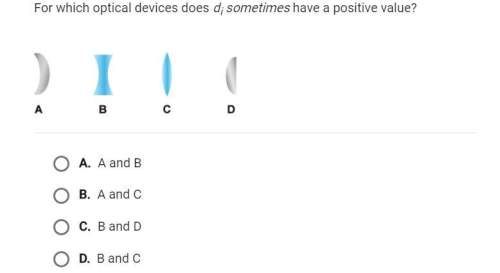
Physics, 21.01.2020 20:31 jonnydean0817
The engineer of a passenger train traveling at 25.0m/s sights a freight train whose caboose is 200m ahead on the same track. the freight train is traveling at 15.0 m/s in the same direction as the passenger train. the engineer of the passenger train immediatly applies the brakes causing a constant acceleration of .100m/s^2 in a direction opposite to the trains velocity, while the freight train continues with constant speed. will there be a collision?

Answers: 2


Another question on Physics

Physics, 22.06.2019 14:30
Which of the following bonds would be most polar? a. c-i b. c-br c. c-cl d. c-f e. c-o
Answers: 1

Physics, 22.06.2019 15:50
The space between two 15-in.-long concentric cylinders is filled with glycerin (viscosity = 8.5 × 10-3 lb·s/ft2). the inner cylinder has a radius of 1 in. and the gap width between cylinders is 0.1 in. determine (a) the torque and (b) the power required to rotate the inner cylinder at 180 rev/min. the outer cylinder is fixed. assume the velocity distribution in the gap to be linear.
Answers: 2

Physics, 22.06.2019 20:20
An electron is trapped at a defect in a crystal. the defect may be modeled as a one-dimensional, rigid-walled box of width 1.00 nm. (a) sketch the wavefunctions and probability densities for the n 1 and n 2 states. (b) for the n 1 state, nd the probability of nding the electron between x1 0.15 nm and x2 0.35 nm, where x 0 is the left side of the box. (c) repeat (b) for the n 2 state. (d) calculate the energies in electron volts of the n 1 and n 2 states
Answers: 1

Physics, 22.06.2019 21:20
Abeverage can is made of 3004-h19 aluminum alloy (elastic modulus 69 gpa, tensile yield strength 285 mpa, density 2.72 g/cm^3). the dimensions on the can are approximated as a thin-walled cylinder with a height of 4.83 inches, diameter of 2.60 inches. empty the can has a mass of 14.2 g. determine: a. the wall thickness of the cylinder b. assuming a pinned-pinned condition what is the critical load? c. assuming a fixed-fixed condition what is the critical load?
Answers: 1
You know the right answer?
The engineer of a passenger train traveling at 25.0m/s sights a freight train whose caboose is 200m...
Questions






English, 04.08.2020 01:01


Mathematics, 04.08.2020 01:01

Chemistry, 04.08.2020 01:01

Chemistry, 04.08.2020 01:01



Mathematics, 04.08.2020 01:01



History, 04.08.2020 01:01



Mathematics, 04.08.2020 01:01




